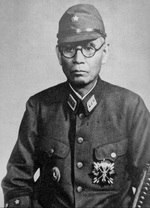Yasuji Okamura
| Surname | Okamura |
| Given Name | Yasuji |
| Born | 15 May 1884 |
| Died | 2 Sep 1966 |
| Country | Japan |
| Category | Military-Ground |
| Gender | Male |
Contributor: C. Peter Chen
ww2dbaseYasuji Okamura was born in Tokyo, Japan. He attended Waseda University in 1897, the Tokyo Junior Army School and Army Central Junior School in 1898, then the Japanese Army Military Academy from 1900 until 1904. In the early 1910s, he was an instructor at the Japanese Army Academy, where he was placed in charge of Chinese cadets and officer candidates for some years; in this capacity he made personal and professional acquaintances with several future Chinese Army senior officers who would oppose him on the other side of the battlefield. He was posted to China as the vice chief of staff of the Shanghai Expeditionary Army and the Kwantung Army between 1932 and 1933, and played a direct role in recruiting Korean-Japanese women from Nagasaki Prefecture into military brothels in Shanghai, as noted in his memoirs. He was promoted to the rank of lieutenant general in 1936 with command over the Japanese 2nd Division. In 1938, as the commander of the 11th Army, he participated in a number of battles in China, including the key battles at Wuhan, Nanchang, and Changsha. In Apr 1940, he was promoted to the rank of a full general, followed by the appointment of the commander of the Northern China Area Force three months later. In Dec 1941, Okamura received and obeyed the scorched earth policies dictated by his superiors under army order number 575; his troops were responsible for the killing of over two million Chinese, mostly civilians in Hebei and Shandong, as the result of this order. the authorization for implementation of the sanko sakusen operation. In 1944, Okamura was the commander of Operation Ichigo in southern China with personal command of the 6th Army. Later in the same year he was appointed commander of the China Expeditionary Army. At the end of WW2, Okamura represented Japan in the China-Burma-India Theater in the surrender ceremony in Nanjing on 9 Sep 1945. Despite his usage of chemical weapons during the war which was specifically banned by the Geneva convention and his indiscriminate killing of Chinese civilians, he was not charged with any war crimes. This was largely due to his pre-war friendship with several Chinese leaders, including the influential He Yingqin, as well as Chiang Kaishek's interest in hiring him as a military advisor. He would indeed serve with the Nationalist Chinese military for 10 years before returning to Japan. He passed away in 1966.
ww2dbaseSources:
David Chandler, Robert Cribb, Li Narangoa, End of Empire
Wikipedia.
Last Major Revision: May 2007
Yasuji Okamura Interactive Map
Photographs
 |  |
Yasuji Okamura Timeline
| 15 May 1884 | Yasuji Okamura was born. |
| 13 Sep 1939 | Yasuji Okamura moved his command center for Japanese 11th Army to Xianning, Hubei Province, China in preparation for the upcoming attack on Changsha in the neighboring Hunan Province. |
| 15 Aug 1945 | General Yasuji Okamura received orders to surrender to the Chinese. He initially contemplated disobeying this order, but would ultimately comply. |
| 20 Aug 1945 | General Yasuji Okamura ordered all units under his command to cooperate with Chinese Nationalists and to oppose any anti-Nationalist and anti-Japanese actions that might be taken by the Chinese Communists. |
| 2 Sep 1966 | Yasuji Okamura passed away. |
Please consider supporting us on Patreon. Even $1 per month will go a long way! Thank you. Please help us spread the word: Stay updated with WW2DB: |
Visitor Submitted Comments
All visitor submitted comments are opinions of those making the submissions and do not reflect views of WW2DB.

» First Battle of Hebei
» Battle of Wuhan
» Battle of Nanchang
» Battle of Suixian-Zaoyang
» First Battle of Changsha
» Battle of Exi
» Operation Ichigo
» Japan's Surrender
Document(s):
» Japanese Instrument of Surrender to China
- » 1,182 biographies
- » 337 events
- » 45,132 timeline entries
- » 1,249 ships
- » 350 aircraft models
- » 207 vehicle models
- » 376 weapon models
- » 123 historical documents
- » 261 facilities
- » 470 book reviews
- » 28,431 photos
- » 365 maps
Winston Churchill
22 Jan 2012 11:03:29 AM
it seems ironic that tha chinese nationalist allowed okamuro to be their adviser after what his men did to them.